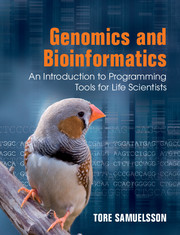Book contents
- Frontmatter
- Contents
- Preface
- Acknowledgements
- Design and conventions of this book
- 1 Introduction: working with the molecules of life in the computer
- 2 Gene technology: cutting DNA
- 3 Gene technology: knocking genes down
- 4 Gene technology: amplifying DNA
- 5 Human disease: when DNA sequences are toxic
- 6 Human disease: iron imbalance and the iron responsive element
- 7 Human disease: cancer as a result of aberrant proteins
- 8 Evolution: what makes us human?
- 9 Evolution: resolving a criminal case
- 10 Evolution: the sad case of the Tasmanian tiger
- 11 A function to every gene: termites, metagenomics and learning about the function of a sequence
- 12 A function to every gene: royal blood and order in the sequence universe
- 13 A function to every gene: a slimy molecule
- 14 Information resources: learning about flu viruses
- 15 Finding genes: going ashore at CpG islands
- 16 Finding genes: in the world of snurpsp
- 17 Finding genes: hunting for the distant RNA relatives
- 18 Personal genomes: the differences between you and me
- 19 Personal genomes: what’s in my genome?
- 20 Personal genomes: details of family genetics
- Appendix I Brief Unix reference
- Appendix II A selection of biological sequence analysis software
- Appendix III A short Perl reference
- Appendix IV A brief introduction to R
- Index
- References
5 - Human disease: when DNA sequences are toxic
Published online by Cambridge University Press: 05 August 2012
- Frontmatter
- Contents
- Preface
- Acknowledgements
- Design and conventions of this book
- 1 Introduction: working with the molecules of life in the computer
- 2 Gene technology: cutting DNA
- 3 Gene technology: knocking genes down
- 4 Gene technology: amplifying DNA
- 5 Human disease: when DNA sequences are toxic
- 6 Human disease: iron imbalance and the iron responsive element
- 7 Human disease: cancer as a result of aberrant proteins
- 8 Evolution: what makes us human?
- 9 Evolution: resolving a criminal case
- 10 Evolution: the sad case of the Tasmanian tiger
- 11 A function to every gene: termites, metagenomics and learning about the function of a sequence
- 12 A function to every gene: royal blood and order in the sequence universe
- 13 A function to every gene: a slimy molecule
- 14 Information resources: learning about flu viruses
- 15 Finding genes: going ashore at CpG islands
- 16 Finding genes: in the world of snurpsp
- 17 Finding genes: hunting for the distant RNA relatives
- 18 Personal genomes: the differences between you and me
- 19 Personal genomes: what’s in my genome?
- 20 Personal genomes: details of family genetics
- Appendix I Brief Unix reference
- Appendix II A selection of biological sequence analysis software
- Appendix III A short Perl reference
- Appendix IV A brief introduction to R
- Index
- References
Summary
It consists essentially in a spasmodic action of all the voluntary muscles of the system, of involuntary and more or less irregular motions of the extremities, face and trunk…. The first indications of its appearance are spasmodic twitching of the extremities, generally of the fingers which gradually extend and involve all the involuntary muscles. This derangement of muscular action is by no means uniform; in some cases it exists to a greater, in others to a lesser, extent, but in all cases gradually induces a state of more or less perfect dementia.
(Charles Oscar Waters, 1841, describing what is now known as Huntington's disease)After a discussion of gene technology methods in the preceding chapters, we now turn to a few topics of more immediate medical interest. We will be dealing with different kinds of human diseases that have a genetic component and see how some aspects of these diseases may be examined using bioinformatics tools such as Perl.
Inherited disease and changes in DNA
In Chapter 1 we saw how genetic information flows from DNA to proteins. The sequence of bases in DNA determines the sequence of amino acids in protein and that sequence in turn determines the biological function of the protein. The relationship between genetic information in the form of DNA sequences and biological function in proteins has been demonstrated by numerous experiments carried out in molecular biology laboratories. At the same time it is intriguing to note that this relationship is also elegantly demonstrated in nature. Thus, we know of numerous examples of naturally occurring changes in DNA that have marked effects on the function of the corresponding protein. Such changes often give rise to disease. In discussing this further we need to clarify what types of alterations are observed in DNA. We may distinguish two major categories. First, there are highly local changes, such as point mutations (single nucleotide changes) and addition or deletion of a smaller number of nucleotides. Second, there are large-scale rearrangements of DNA sequences that result from DNA recombination events.
Information
- Type
- Chapter
- Information
- Genomics and BioinformaticsAn Introduction to Programming Tools for Life Scientists, pp. 55 - 65Publisher: Cambridge University PressPrint publication year: 2012
